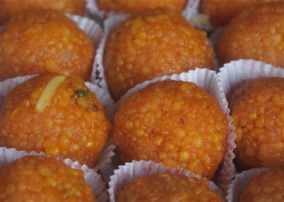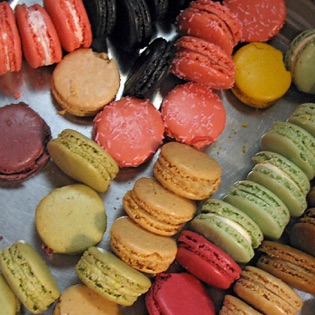laddu (also laddoo) South Asia
To make this most ubiquitous of the subcontinent’s desserts you take a thinnish batter (typically based on chickpea flour though there are variations that use sesame or semolina) and deep-fry it in hot butter in the form of little drops. These drops, now looking a little like corn kernels, are then soaked in saffron-tinted sugar syrup. This is referred to as bonde. When you form it into two-bite-sized balls it is called a laddu.
lady finger UK, US, savoiardi Italy
coming soon
Linzer dough: a rich buttery dough made with flour, butter, egg and almonds though contemporary recipes sometimes use hazelnuts instead. This was traditionally used to make Linzer tortes (see below) but today is often to make rolled “Linzer” cookies which may or may not be filled jam.
The Linzertorte has a long storied history that goes back to at least 1653. The illustration on the left comes from the Conrad’s Hagger’s magnificent
Neues saltzburgisches Koch‐Buch (1719). In common English usage, most people would describe it as a tart rather than a cake. Up until the nineteenth century it was made exclusively with an almond and flour dough enriched with butter, then spread with jam (raspberry or red currant were most typical) and a latice crust. Contemporary recipes often call for hazelnuts.
lokum, Turkish delight Turkey, Middle East
A confection made by thickening sugar syrup with starch yielding a very dense, chewy jelly. It is typically brightly colored and traditionally flavored with rosewater and mastic though contemporary confectioners have a much wider repertoire. Istanbul‘s premiere confectioner,
Hacı Bekir offers some 2 dozen varieties.
The origin of lokum is mostly likely medieval Persia, where a very similar confection called fālūdhaj, was made by thickening honey with starch.
luqmat al qadi Middle East, loukoumades Greece, lokma Turkey
A yeast-risen fritter made roughly the shape and size to a Ping-Pong ball. Once fried, it is soaked in sugar syrup. It makes its first appearance in a thirteenth-century recipe collection by al-Baghdadi, there called
luqam al‐qādī or “judge’s morsel.”
An almond meringue cookie. Two of these are often sandwiched around a flavored buttercream or ganache filling. Trendy variations have included everything
from passionfruit to foie gras! The cookie seems to date to the Italian renaissance and was probably introduced in France in the late 16th or early 17th centuries. The name derives from the Italian maccheroni and may refer to the shape (early maccheroni were more like gnocchi than pasta) or perhaps they were originally made by the same Italian immigrants who sold maccheroni. Or both? Though macarons were being sandwiched with fruit preserves at least as early as the 19th century, the buttercream-filled variety only seems to date from the 1950’s. According to
Ladurée (perhaps the earliest proponents of the modern filled macaron–see photo) it was Pierre Desfontaines, a distant cousin of the Parisian shop’s first owner who came up with the idea.
A small cake/cookie made of a rich sponge cake batter in a special mold that resembles an elongated scallop. The cookie became a celebrity after Marcel Proust used it in the opening of his masterwork,
A la récherche du temps perdu. According to the 19th century pastry chronicler Pierre Lacam, the cookie was “invented” by a pastry cook to Prince Talleyrand named Avice. “He had the idea of using
tôt -fait or
quatre-quarts mixture [the first is roughly pound cake, the second is similar with fewer eggs] for little cakes baked in an aspic mold. M. Boucher and Carême approved the idea. He gave the name of madeleines to these cakes.” (Lacam,
Mémorial de la pâtisserie) The Comte de Courchamps, writing a couple of generations earlier, credits the name to a certain Madeleine Paumier (
Néo-physiologie du goût, 311) who worked for madame Perrotin de Barmond at the court of Louis XV. (A popular claim has her based in Lorraine which doesn’t make a whole lot of sense.) Wherever the name comes from, the idea of baking little spongecakes in molds goes back at least a hundred years earlier.
Buns stuffed with sweet adzuki bean. “Before Edo period they had many different fillings, including vegetables.”
Eric C. Rath, Food and Fantasy in Early Modern Japan (Berkeley: U. of California Press, 2010), 91.
marshmallow US, UK, guimauve France
Early on,
marshmallows were a kind of throat lozenge made of the marsh mallow plant. Later versions were closer to the confection we would recognize today made by whipping up egg whites, sugar, and the sticky extrusion of the same plant. In the twentieth century industrially produced gelatin replaced the root extract.
The
mazanec is a cousin to the many sweet, enriched breads/cakes such as the
panettone and
paska typical of some European holidays. In this case it takes the form of a buttery yeast-leavened cake made in the form of a round loaf and is traditional for Easter. It is typically very lightly spiced with anise and nutmeg and generously studded with raisins and almonds.
Photo: apetitonline.cz
Sweets that consist of one bite, smaller than petits fours. According to Sébastien Canonne, a founder of the French Pastry School in Chicago, the range has three basic categories: sec (dry and crunchy, like tuiles or sables); moelleux (soft, like madeleines or financiers) or frais (with fresh ingredients like pastry cream or fruit, which must be eaten soon after they are combined, like eclairs and tarts).” NYT, 26 Oct. 2011 Mignardises
A Bengali dessert made by adding yogurt cultures to partially evaporated milk.
A sweet rice cake made with glutinous rice. The dough is often use to wrap a filling such as bean paste or more recently nuggets of ice cream. Similar rice flour doughs are used throughout East and South Asia.
mochi
A sandwich cookie made with two round graham cracker-type layers that sandwich a filling of marshmallow. This is then dipped in chocolate or other flavors. Originated by the
Chattanooga Bakery in 1917. Not to be confused with the “half-moon pie,” long a synonym for a turnover.
























